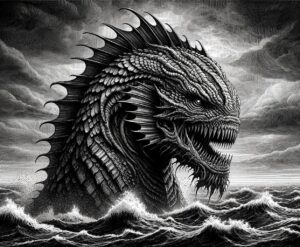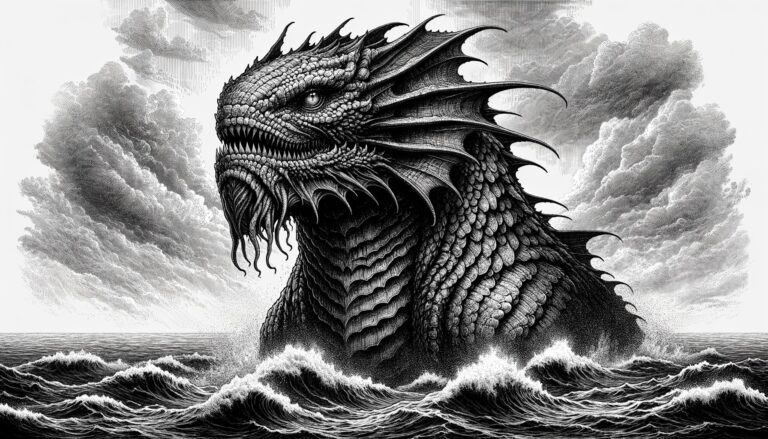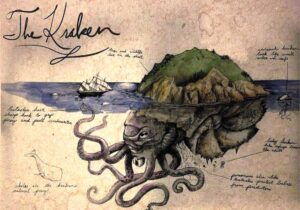Table of Contents
An uneasy feeling rises as the ship sails through the Mediterranean, its waters beginning to churn ominously from the bow. You embarked on this journey with a sense of foreboding, and now the events unfolding before your eyes only intensify that unease. Two beams of glowing light pierce the water’s surface, and as the sea starts to boil, a feeling of impending doom settles in your heart. The armored scales of a fearsome creature rise from the depths, and you realize with dread that Leviathan is upon you – these moments may well be your last.
What is the Leviathan?

Leviathan, a legendary sea monster, has been a source of fascination for Christians and non-believers alike since it was first mentioned in the Bible. Leviathan is portrayed as a formidable primordial being that once ruled over all the creatures of the sea. Various descriptions of its origins and intentions have emerged over time, but a common thread is its capacity for terrifying destruction.
Origins
Leviathan is depicted as an enormous sea monster, one of Yahweh’s (the Christian god) original creations. Although other powerful creatures were also brought into existence, Leviathan was considered the most dangerous. The origins of the Leviathan’s tales vary, but many aim to demonstrate the immense power of Yahweh.
Possible Adaptation
Some theories suggest that Leviathan was incorporated into Christian religion to facilitate the conversion of people from other cultures. Ancient myths from pre-Christian cultures often tell of a mighty sea serpent vanquished by a benevolent protective deity. This raises questions about whether the Leviathan legend was inspired by a real creature, interpreted differently across various religions and cultures.
Leviathan is Created
Leviathan was among the first creatures ever made and was one of three primordial beings entrusted with great power on Earth. Behemoth, a bull-like creature, was given dominion over the land. Ziz, a dragon-like creature, ruled the skies. Leviathan’s domain was the seas, with the Mediterranean as its home. It was considered the most powerful, perhaps due to the sea’s inherent dangers and its reputation for destruction, unlike the peaceful Behemoth and Ziz.
Initially, there were believed to be two Leviathans – male and female, created to be companions in the seas. As time passed, it became apparent that both could not coexist. Either they would take over the world if allowed to reproduce, or one had become corrupted, transforming into a creature of immense destructive power.
Yahweh’s Battle

To protect his other creations, Yahweh descended to Earth and engaged in a mighty struggle with the female Leviathan, known for her incredible strength. Despite her resistance, Yahweh’s omnipotence eventually prevailed, saving his other creations from certain destruction. The male Leviathan now harbors bitterness and awaits a final battle with Yahweh.
After defeating the female Leviathan, Yahweh employed her skin to create an exquisite canopy. The Leviathan possessed one of the most beautiful skins among all of Yahweh’s creatures, rendering the canopy truly extraordinary. Under this canopy, a feast made from the Leviathan’s flesh awaits. It is believed that during the rapture, the righteous will dine with Yahweh under this canopy, partaking in the flesh of both Leviathans and Behemoth.
Furthermore, Yahweh used the remaining skin of the female Leviathan to fashion ‘Garments of Light’ for Adam and Eve. Despite their disobedience by eating the forbidden fruit, Yahweh ensured their protection on Earth with these special clothes.
Leviathan is a central figure in many creation stories that aim to highlight Yahweh’s incredible power. By creating the most potent creatures on land, in the seas, and in the skies, Yahweh demonstrated his supreme might, humbling all other creations. However, Leviathan presented a unique challenge to early cultures. It was the only one of the three primordial beings known for its destructive nature and was largely regarded as malevolent. In addition to being extremely dangerous, it was considered impossible for humans alone to defeat.
Description and Attributes
Legend tells us that Leviathan was at least 300 miles long, a size beyond human comprehension. This mighty sea creature possessed a fiery temper feared by all and impenetrable armored scales that made it invulnerable. The scales were so closely layered that not even air could penetrate them, a testament to the beast’s might.
Despite its fearsome qualities, Leviathan was also renowned for its unique beauty. The creature exhibited fluorescent characteristics, with dimly glowing eyes that intensified when its head surfaced. Its skin had a beautiful glow, especially its flippers, which appeared to bear halos floating above them.
Special Abilities

Perhaps most terrifying of all was Leviathan’s capacity for causing chaos, especially among Yahweh’s chosen creatures. The creature wasn’t inherently evil but took pleasure in sowing disorder.
Leviathan could breathe fire, with flames erupting from its mouth, nostrils, and even eyes above the surface.
It could make the water around itself boil, a deadly ability used for hunting prey and terrorizing humans.
The creature’s breath was exceedingly foul, toxic enough to kill anyone or anything that encountered it. Leviathan’s breath was believed to be potent enough to annihilate all living things in Paradise.
Connections to Earlier Mythology
While Christianity maintains the Leviathan as an original legend, earlier stories from different cultures cast doubt on this claim. There are significant overlaps in these tales, leading to two main conclusions.
One, Christians may have used the motif of an all-powerful deity overcoming sea serpents to facilitate conversions from other cultures. This theory aligns with Christianity’s historical practice of adapting existing myths to promote conversion.
Two, there could have been a real sea creature that inspired these myths. Some scholars propose that the Leviathan was exaggerated from encounters with undiscovered or extinct sea creatures.
Leviathan in Different Religions:
Leviathan is not confined to Christian mythology. It appears in Judaism, Satanism, and other belief systems, often symbolizing power and chaos.
Leviathan in Christianity:
In Christianity, Leviathan was initially seen as a powerful entity, almost akin to a god, vanquished only by Yahweh. Over time, it evolved into a demon beast subdued by Yahweh. Some interpretations link Leviathan to one of the seven deadly sins, specifically envy, or even as an alternative image for Satan.
Leviathan in Judaism:
Jewish texts offer differing accounts of Leviathan. One portrays it as a female dragon dwelling in the ocean’s depths, to be consumed by the righteous at the end of time. Another version suggests a male Leviathan, with the female’s flesh reportedly provided as food for the Hebrews during their wilderness journey. These texts also describe the creature’s biology, including its voracious appetite for whales and vulnerability to a creature called the kilbit.
Leviathan in the Satanic Bible:
The Satanic Bible also mentions Leviathan, associating it with the water element and the western directions. Leviathan is considered one of the four Crowned Princes of Hell, a position of great power and reverence. Notably, it is also linked to Baphomet, a deity associated with the Knights Templar, with each point on the Sigil of Baphomet representing Leviathan.
The Hell Mouth:
In time, Leviathan became associated with the “Hell Mouth,” believed to be the creature’s mouth set to rise during the end times. It is said that the damned and non-believers will be devoured by the Hell Mouth during the final judgment. Afterward, Yahweh will descend upon Earth for a final battle with Leviathan, and the flesh of the defeated creature will be served to the righteous.
Origin of the Myth:
Numerous theories attempt to explain the origins of the Leviathan myth. One suggests that Christianity adapted existing myths from other cultures to ease conversions. Another speculates that the myth may have been inspired by an undiscovered sea creature. Some even propose that Leviathan could be an exaggerated representation of creatures known today.
Hadad (Baal) Versus Lotan:
In Babylonian mythology, the storm god Hadad (or Baal) encounters a seven-headed dragon creature named Lotan, a threat to creation. Hadad’s victory over Lotan is followed by the creation of the world from the serpent’s body.
Marduk Versus Tiamat:
Babylonian mythology also features the story of Tiamat, a powerful entity taking the form of a fiery dragon or watery Chaos, similar to Leviathan. Marduk, a young god, defeats Tiamat in battle and uses her corpse to create the heavens and the earth.
Zeus Versus Typhon:
Greek mythology recounts Zeus’s confrontation with Typhon, a terrible serpent beast. Zeus ultimately defeats Typhon by trapping him under a giant mountain.
Thor Versus Jormungandr:
In Norse mythology, Thor faces Jormungandr, a serpent so vast that it encircles the world. Their battles, including one during Ragnarök, parallel the Leviathan myth.
Leviathan, the mythical sea monster, has left an indelible mark on religious lore, transcending boundaries and time. Whether a symbol of chaos, power, or divine intervention, Leviathan continues to captivate the human imagination. Its origins, while shrouded in mystery, reveal the enduring power of myth and legend in our collective consciousness.
FAQ
Which cultures feature Leviathan in their myths?
Leviathan appears in Christian, Jewish, and Satanic myths, among others.
What does Leviathan symbolize?
Leviathan symbolizes power, chaos, and divine forces in mythology.
Is Leviathan real or mythical?
Leviathan is a mythical creature; there's no scientific evidence of its existence.
How big is Leviathan in legends?
Leviathan's size varies but is often described as immense, with some legends claiming lengths of hundreds of miles.
How does Leviathan appear in different religions?
Leviathan has diverse roles, from a powerful entity to a demonic creature, depending on the religion.
What's the origin of the Leviathan myth?
Leviathan's origins are unclear, possibly adapted from other cultures or inspired by real or unknown creatures.
What are some famous battles involving Leviathan?
Leviathan battles deities or heroes in myths, such as Hadad vs. Lotan or Zeus vs. Typhon.
What's the significance of Leviathan in modern culture?
Leviathan continues to inspire art, literature, and popular culture as a symbol of mystery and power.
Is there any scientific basis for Leviathan's existence?
No, Leviathan is purely a product of mythology and folklore with no scientific basis.




